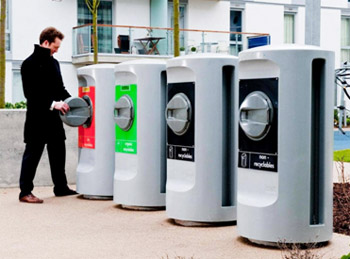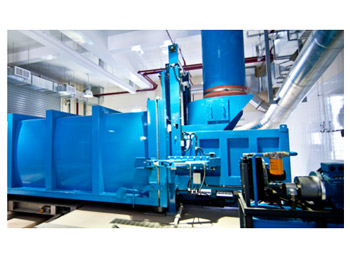

Automated or Pneumatic waste collection systems have been around for decades, they are experiencing an upsurge in popularity, as cities are becoming increasingly aware of the problems related to conventional methods of waste collection. The trend to incorporate automated waste collection systems into new housing development projects is rising, particularly in Europe, and in Asia where South Korea, Taiwan and Hong Kong are leading the way in implementing this type of technology.
Users of the pneumatic waste collection system deposit their refuse into waste inlets, located around the chosen operating area. Waste collection points are placed outdoors or indoors and are accessible 24 hours a day. There is one waste inlet for each type of refuse (which will typically be divided into mixed waste, organic waste and paper waste). The refuse is temporarily stored by the waste inlets until the next emptying cycle.

The refuse is then transported along the pipelines into containers at the waste station. When full, the containers are sent away for further processing using, for example, the city’s existing underground railway network.
The system is remotely monitored and controlled by operators at the waste station. In addition, some staff are needed to handle the system maintenance when required. No personnel are needed in the actual collection and transport of waste from the collection point to the waste station.

As well as savings from reduced personnel costs, waste vehicle and fuel costs, there are various ways in which automated waste collection systems benefit not only the city image but the environment.
One of the main environmental benefits is reduced CO2 emissions, which is a result of reduced waste vehicle traffic. Reduced waste vehicle traffic also means a more pleasant and safe environment for people living in the area where the system is in use.
Typical application areas for pneumatic collection systems include large metropolitan and residential areas, high-rise buildings, public spaces, healthcare facilities, and hotel and office complexes.
The system life cycle depends on several factors, such as the amount of collected waste, the climate of the operating environment and ground conditions.This system is designed to last for at least 50 years (this applies to the pipeline and waste inlets).
Waste inlets are the points where the users deposit their refuse bags. Each waste collection point incorporates as many waste inlets as there are types of refuse. There are various classifications for waste fractions. The most commonly used waste fractions in pneumatic waste collection systems are: mixed waste, organic waste and paper. Alternatively, the waste can be sorted at recycling centres. In this case, there is only one waste inlet per collection point.
Residential waste inlets can be located indoors or outdoors.Outdoor waste points are preferred for sparsely populated areas because of their lower construction costs. It is often a good idea to equip residential outdoor waste inlets with locks to prevent unauthorized usage. An alternative method is to use RFID (Radio frequency identification) tags to identify the users.
Depending on the amount of waste generated, the capacity of the waste inlet, and the size of the system, the emptying interval may vary between hours and days. All waste inlets incorporate sensors for the detection of the refuse level. This prevents overflow while eliminating the unnecessary emptying of waste inlets.

The main network typically comprises 500 mm diameter steel pipes that are hermetically welded. Any major wearing of the pipe is the result of abrasion by the transported material, in particular, hard and edgy materials such as glass or metal refuse with the most significant pipe wear occurring at bends.
Typically, the waste station is located as far as 2 km and go up to 10km to 15km from the waste collection points. The entire network can be monitored and controlled by the waste station operators. At least one container is required for each waste type. It is also possible to connect the waste station to the existing public transportation rail network.
The number of waste containers is dependent on the number of waste fractions, waste volume and emptying frequency. For biowaste, a tank is used instead of a container. Full waste containers remain closed and the only time a container is in contact with air is when a full container is replaced by an empty one; this ensures that high levels of hygiene are maintained throughout the system.

Pneumatic waste collection systems provide notable long-term cost savings. In order to operate, systems require personnel at the waste station and for maintenance but no manpower is needed in the actual collection and transportation of waste to the waste station. In addition, no waste trucks are needed to collect waste containers from residential areas, bringing savings in fuel costs and vehicle costs.
While the initial investment cost for a pneumatic system is higher than that of traditional methods, the operating cost of the old system is usually considerably higher, the pneumatic system is considerably more economical than the conventional one.
In addition to cost savings, pneumatic waste management systems have environmental benefits. As there are no waste collection trucks circling around the residential areas, there are less fuel emissions, less traffic and fewer accidents. It has also been discovered that the waste collection points of the pneumatic system encourage the users to recycle more efficiently. The inlets are never full and the fact that there are no unsightly piles of waste or unpleasant odours is beneficial for both the cleanliness and image of the area. Another benefit is that a pipeline-based waste collection system is very flexible and the system does not get congested even at peak times.
Automated waste conveying systems are typically used in large, modern metropolitan areas as well as residential areas, and in healthcare facilities, town shopping centres or airports.
Residential solutions are used in highly populated areas with high-rise buildings. The buildings are linked to main pipeline and replaceable containers are used. An economically feasible size for this system is 500+ households. The full-fledged metropolitan waste system is suitable for large residential areas with over 20,000 households. The replaceable containers can be collected by metro/underground trains from the waste station.
Smaller-scale pneumatic waste systems are ideal for shopping centres or airports where the installation of a comprehensive system is not as economically feasible. A waste collection system in a public space improves the image of its surroundings by eliminating overfilled waste bins and improving hygiene. Optional waste-bin fire detectors also improve safety.